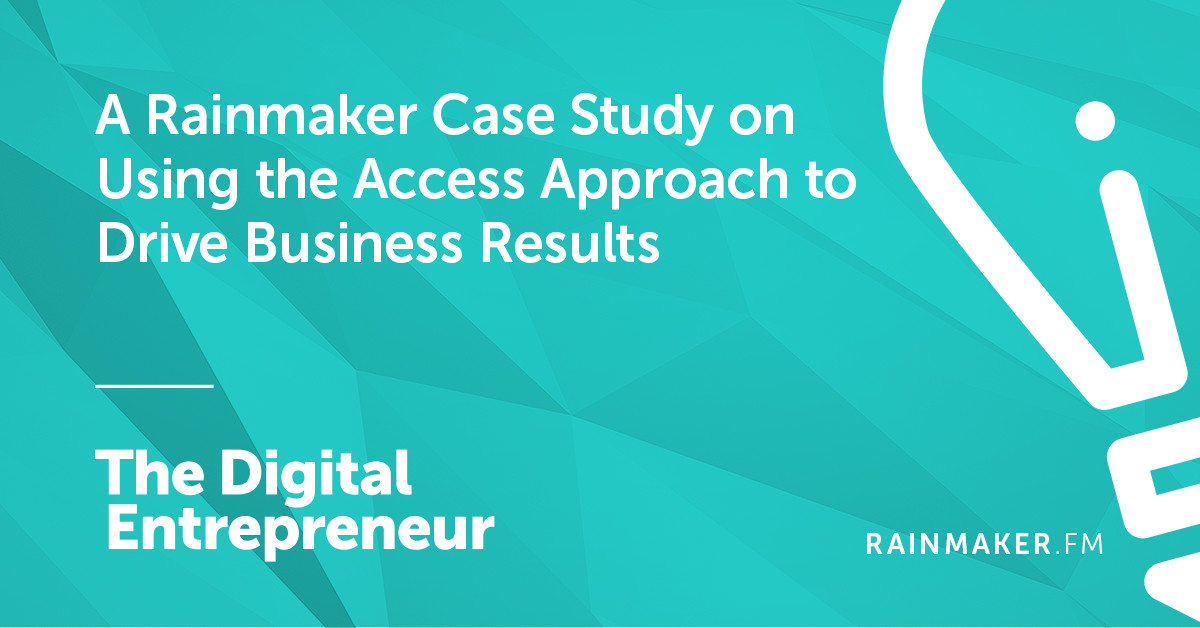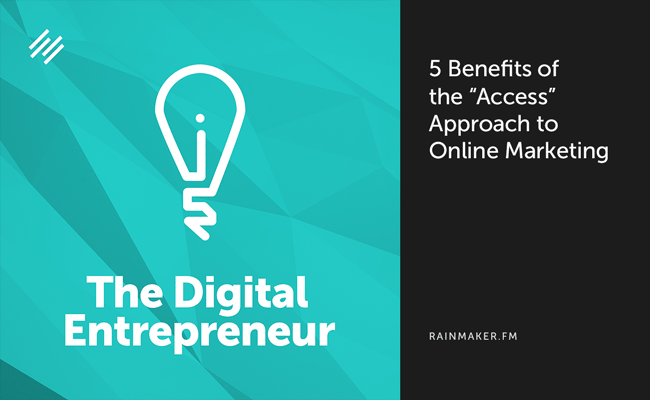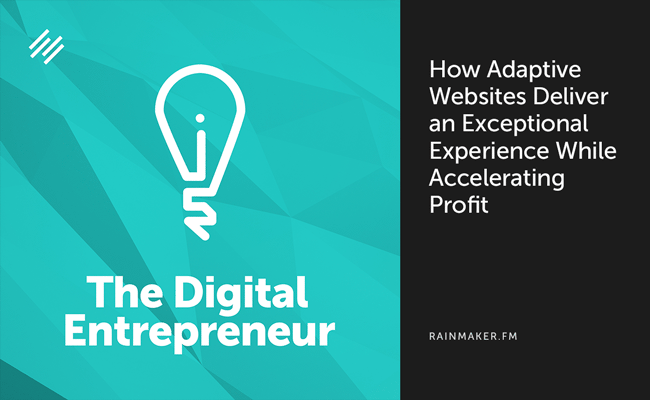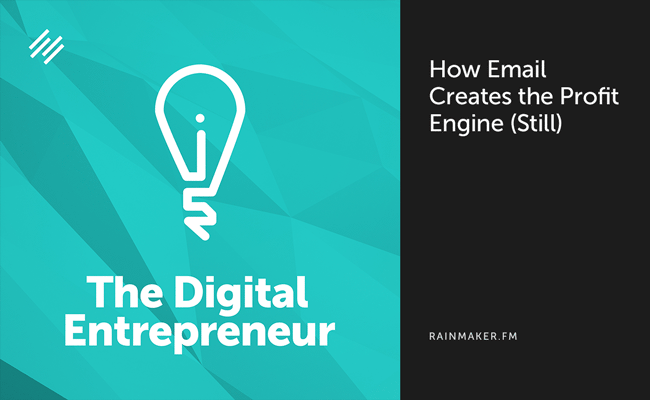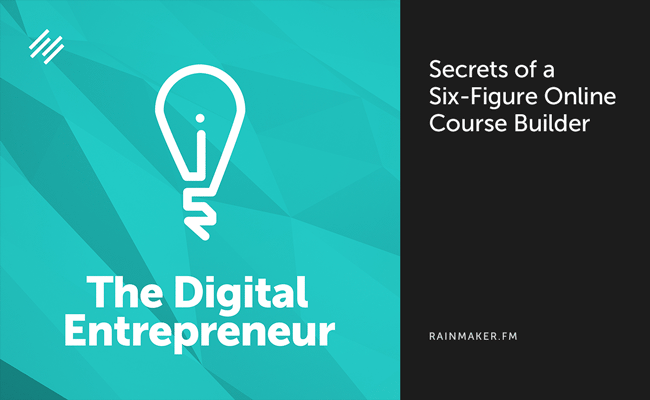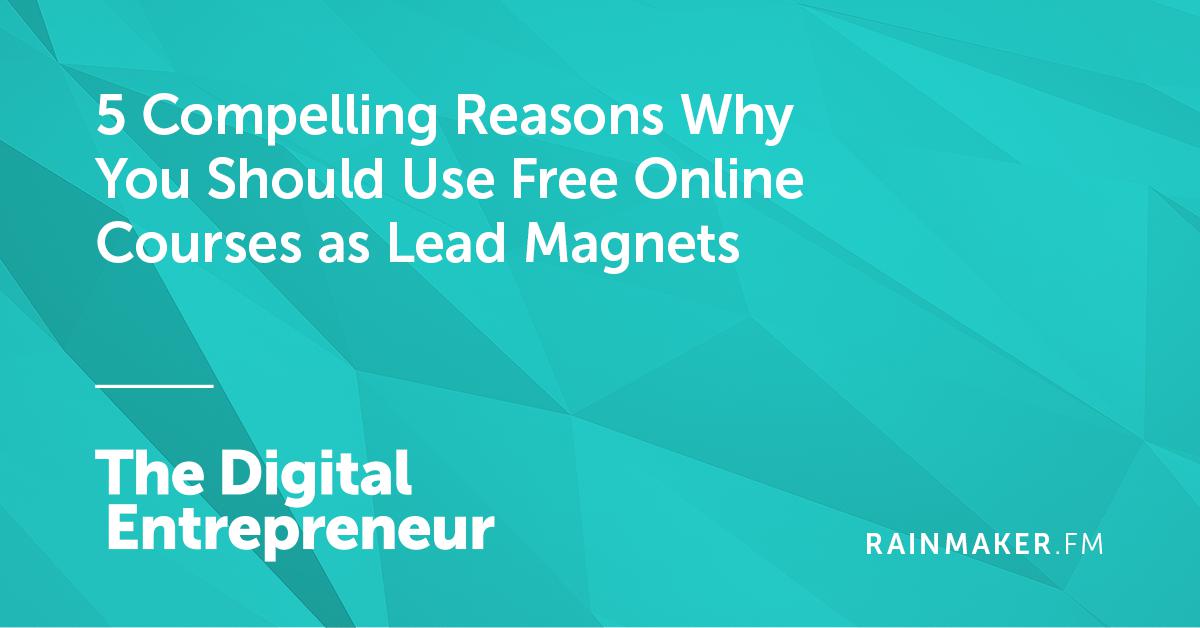
This is the fourth episode in our ongoing series on the essential elements of the modern marketing website. Today we take the next step after access, and break it down by using free online courses as the perfect lead magnet for digital entrepreneurs.
In this 22-minute episode, Brian Clark and Jerod Morris discuss:
- How free online courses help you carve out attention (and authority)
- What the topic of your course allows you to learn about your prospects
- Why a free online course helps you solve the identity issue
- How you can adapt the experience for the people who take your free course
- What this all means for conversion
Listen to The Digital Entrepreneur below …
The Show Notes
- Episode 1: How Email (Still) Creates the Profit Engine of Your Digital Business
- Episode 2: How Adaptive Websites Deliver an Exceptional Experience While Accelerating Profit
- Episode 3: 5 Benefits of the ‘Access’ Approach to Online Marketing
- Digital Commerce Institute
- Brian Clark
- Jerod Morris
The Transcript
5 Compelling Reasons Why You Should Use Free Online Courses As Lead Magnets
Voiceover: You are listening to The Digital Entrepreneur, the show for folks who want to discover smarter ways to create and sell profitable digital goods and services. This podcast is a production of Digital Commerce Institute, the place to be for digital entrepreneurs.
DCI features an in-depth, ongoing instructional academy, plus a live education and networking summit where entrepreneurs from across the globe meet in person. For more information, go to Rainmaker.FM/DigitalCommerce.
Jerod Morris: Welcome back to The Digital Entrepreneur. I’m your host Jerod Morris, the VP of marketing for Rainmaker Digital, and I am joined this week by Brian Clark, the founder and CEO of Rainmaker Digital.
Brian, the last time we talked, you were preparing for a trip to the Philippines. How did you manage the long flight? Did you get as much work done as we had hoped for?
Brian Clark: Not really. It’s interesting because I also didn’t really sleep. I was just so exhausted the whole time that I watched a whole bunch of movies. Going over there, I was just trying to make it. That was, by far, the longest series of flights I’ve ever had. Coming back was easier. I guess once you understand what you’re in for, and the long leg of the flight this time was 10 hours instead of 13. That makes a difference, trust me.
Jerod Morris: Oh, I’m sure it does.
Brian Clark: But I got back, worked it so that I would go to bed early the day I got home and start waking up really early, which was one of my goals coming out of the conference. As you know, I’ve been up at four and five in the morning pummeling you with emails. But you also get up early, so it actually works out.
Jerod Morris: It did. It worked out great.
Brian Clark: With you in Central time zone, I actually have to get up an hour earlier than you just to be even with you, but it’s all good. I’m feeling back to normal a bit but, actually, more productive now because I’ve implemented this new morning routine. I’m just much more productive in the morning, but by three in the afternoon, I’m pretty much done. Just stick a fork in me.
Jerod Morris: I’m the exact same way. I get so much done when I get up early, so I like to do it. We had some fun while you were gone. Robert joined us. Chris joined us. We had a really good discussion on last week’s episode really linking together what you and I talked about before with adaptive websites and what we’re going to talk about today with free online courses.
Talked with Robert. He took us back to the beginning of the New Rainmaker strategy, talked some about that. We got some of Chris’ insight on adaptive websites. So you and I now, we’re going to take the next step in the conversation that we’ve been having about these elements of the modern marketing website.
We talked in episode six about the power of an adaptive website, and today, we’re going to talk about why people should be using free online courses as lead magnets. We’ve got five really compelling reasons why this is a good strategy. Any kind of overview statements before we dive in to these five reasons?
Overview
Brian Clark: Well, after we did the adaptive episode, we did the access episode. Access is a broad concept with a whole bunch of benefits that we went over in that episode. A lot of people, that seemed to really resonate with them. Then it’s what kind of access should we provide? There’s all sorts of different things that you can provide access to.
In this episode, we’re really going to make the case for you that, from a marketing standpoint, you really can’t beat providing access through registration to a free online course as the best way to not only begin a relationship with the right prospects, but to convert more of them.
Jerod Morris: Yeah, access. You’re right. I got my A words mixed up. Speaking of A words, that’s the first reason why people should be using a free online course: attention.
How Free Online Courses Help You Carve Out Attention (and Authority)
Brian Clark: Yeah. Even dating back to the old-school funnel, created by a guy named St. Elmo, by the way. I don’t know why no one says ‘St. Elmo’s funnel’ because it just seems perfect, but they don’t.
Attention is the top of the funnel, regardless of the metaphor that you want to use. This is one of the key beginning reasons why we migrated to this type of strategy. Part of the reason why it’s so effective is perceived value.
The days of the crappy PDF ebook or some other kind of marginal lead magnet, in a lot of industries, it just doesn’t work as well because people are like, “Eh, it’s probably not going to be that great. I’m probably going to get spammed and I’d rather just not.” Great content marketing means giving away something–in this case, information–worth paying for. We’ve made this point before.
People are definitely paying for online courses to the tune of $15 billion a year and growing rapidly, so the perceived value of this type of giveaway is much higher. That’s a constant battle that we’re all in–how do we create more perceived value for our prospects, and how do we deliver more actual value?
It begins with perception, and perception is a function of attention and whether or not that attention leads to the next step.
Jerod Morris: Couldn’t you also add another A word here, authority. If you have that perceived value of the course, then when people actually get in the course and they get value and they see your knowledge, you’re also building authority here, too, aren’t you?
Brian Clark: Yeah, I think so. You establish the authority after they’re involved in the course–let me say, demonstrate authority. In your landing page copy and with your other content, you’re going to have to give indications of authority that way as well for people to find the offer attractive.
But it’s a true authority enhancer once you get them to actually finish the course. As we’ll go through these elements, you’ll see that the fifth one is really compelling, and that’s a big part of it.
Jerod Morris: It is. So attention is the first reason. Let’s move on to the second reason now, which is interest.
What the Topic of Your Course Allows You to Learn About Your Prospects
Brian Clark: Right. Any time you’re trying to get someone something, whether you want to call it a ‘lead magnet,’ an ‘ethical bribe,’ or whatever terminology, you’re offering something to establish what this person is interested in–and by that, I mean what problem are they trying to solve?
By using these very strategic assets based on topical interest or problems to be solved, you’re learning something very important about them. That tells you what content you have to deliver to match up with your business objective at the end–whether that’s selling a product, getting them to call you for consulting, or some other kind of client engagement. You get the idea.
Interest is the bridge between attention and conversion, but it also informs, “What do I have to teach these people in order for more of them to want to do business with me?”
Jerod Morris: We often talk about how one of the benefits of digital products and an information product like a course is that the marketing is really baked into the product. That really comes out here–which, again, helps you develop the product that people are going to need. Then you already understand who those people are, so it’s easier to get it out to them once you have it done.
Brian Clark: Yeah. So my interest is learning how to create online courses. I know what I have to teach you as a preliminary matter to get you to take my broader course. Or you’re selling software or software as a service, and that functionality accomplishes something for people.
But let’s say with Rainmaker Platform, if you’re not well-versed in some of the strategies that the platform allows you to execute on, you’re going to feel lost. That’s just a perfect example of someone has an interest and you’ve got a solution–but what needs to happen in between those two things?
Why a Free Online Course Helps You Solve the Identity Issue
Jerod Morris: Now we move on to a topic that we’ve talked about before on previous episodes. We’ve got attention. We’ve got interest. Now it’s about identity, and again, we’ve talked about how every buyer’s journey is going to be different, and we’ve got to treat them as such. This concept of identity helps us take that first step toward doing that.
Brian Clark: Yeah. Identity is the fundamental opposite of one-size-fits-all marketing blast (you just send out the same message to everyone). Identity really allows adaptive content and automation principles to be used. In this context, it has an advantage over some of the more traditional uses of marketing automation, which rely on cookies.
Again, with an access concept, and specifically with an online course, the registration process provides identity–just like Facebook knows who you are, or Twitter, or Basecamp. Yet because you are experiencing this content marketing–which, make no mistake, that’s what this course is–inside a logged-in experience, then no matter where you come–whether it be your iPad, your iPhone, your desktop, your laptop–the identity piece is always there.
You don’t have the infamous cookie drop where your automation just falls apart because they switched devices on you, and you got this disrupted experience. That’s got to be jarring for everyone, but I definitely think that it impacts the ultimate success of that funnel.
How You Can Adapt the Experience for the People Who Take Your Free Course
Jerod Morris: Yeah. And when you have identity, this then allows you to take the next step. This is the fourth reason why creating a free course is a great thing to do and a great product to use as a lead magnet. You can adapt the content.
This is one of the reasons why creating a free course–for example, using an LMS is so much more beneficial than doing it if you just create it via email–is because you understand who the people are. Then you can adapt the experience to them, which is obviously quite beneficial.
Brian Clark: Yeah. This goes beyond even an access concept. For example, you give away an ebook, some other kind of process map, or a free download of some kind. All you know is, basically, did they opt-in, and did they download it.
If they don’t download it, you can adapt a little there and say, “Hey, don’t forget to download your free strategy guide because you haven’t yet, and we want to make sure you get the blah, blah, blah”–but you know nothing about what happens after that. It’s probably sitting on my hard drive, on my desktop
Actually, I have a reading file in Google Drive that has so many PDFs in it that I have not read. That happens, right? I opted-in. I got the thing. I never consumed it, and your follow-up emails I probably got annoyed with. I hadn’t achieved the benefits of knowledge that I was looking for from that download, so I just opted-out at that point.
With a course, it’s a very different thing, especially in a learning management system, because you know if they’ve consumed the content. Did they take lesson one? Yes. Check. Go on to lesson two. Lesson two, they got halfway through it and stopped.
Now, at that point, you can send a different kind of message that says, “Hey, I know life is distracting and things happen, so I just wanted to give you a gentle reminder that your lessons are still there available to you. Maybe you can pick it back up, blah, blah, blah.”
You see the power there. Could you watch someone with an ebook to find out if they were actually progressing through the information, but were they also progressing through chapter by chapter or page by page? We do have that ability with an access concept married with an LMS-style course.
I know you have done this kind of stuff with your Showrunner course, where you see where people get stuck, and you have tailored messages for them. That’s an amazing thing. That’s real adaptive content. You just can’t achieve that with just a static download.
Jerod Morris: Right. Well, you can even take it to the next level where, if you introduce something like quizzes, not only can you find out if someone’s progressing through the material, you can actually find out if they’re understanding the material and really getting it.
Brian Clark: Yeah. That’s actually a teaching strategy, too. If you test them, they will actually retain better than if you don’t. But you’re right. At the same time, that’s another indication of engagement that is very valuable to how you treat that prospect, someone who’s that highly engaged even at the quiz level–which, by the way, coming in Rainmaker very, very soon, I can’t wait to implement some quiz strategies. We’ll talk about those in the future.
When you see that level of high engagement, you might be more inclined to make an offer sooner than someone, obviously, who’s kind of poking through it, nitpicking here and there, skipping around, or just kind of fell off.
Again, every buyer’s journey is different. Yet if you don’t have the information about what they’re actually doing, consuming, engaging with, then how do you actually tailor that journey for them?
What This All Means for Conversion
Jerod Morris: Yeah. We’re talking about five compelling reasons why you should use free online courses as lead magnets. We’ve hit four of them so far: attention, interest, identity, and adaptation, and of course, now we go on to the fifth one. This brings us back to the ultimate goal with what we’re really trying to accomplish with all of this, which is conversion.
Brian Clark: Yeah. So often, this is really a mystery to me. It’s only because I’ve been doing it a long time, and I’m not being critical of anyone. But content marketing is about educating a prospect, so they can do business with you. It’s not enough to have attention, interest, or any of these other really important things on the way to conversion if you’re off the mark on what you’re teaching and how that is married up to what you’re selling.
When you understand what their problem is and you understand how your solution solves that, a course is like a laser-focused educational experience that can better convert a prospect into a customer or existing customers into repeat or recurring customers.
Now, this is the reason why we say that you need to understand your prospect and your customers almost better than they do. We have all of this information and data that we’re generating through a more adaptive content approach to where you can be constantly refining and testing.
Once you get to a point where you understand that they need to know boom, boom, boom, boom, five lessons, whatever, and that more people convert at the end of that than otherwise, that’s one of the more compelling reasons for this format.
Again, we’ve evolved along the way ourselves. Blogging every day hoping that day’s article connects with the right segment of people, and then maybe tomorrow the next one will connect.
When you create these type of very focused funnels using online courses, you’re going after a specific type of person in a very concentrated period of time with a sale in mind. This is going to be liberating to a lot of content marketers and digital entrepreneurs out there. The days of heavy-duty blogging are kind of over. I’m not saying blogging’s dead. I’m saying that laser-focused content is more effective and, ultimately, when you look at volume, easier to create.
Jerod Morris: Yeah. Like you said, you’re teaching people exactly what they need to know to, and you’re giving them little wins along the way. As you also mentioned, it’s a process then of adapting and figuring out what’s working, figuring out what’s not, adapting the message, adapting the content also to the people that you’re serving and the people that you’re trying to move through and get to take that next step.
The Importance of Testing and Understanding What’s Working, What Needs to Be Tweaked, and What to Double-Down On
Jerod Morris: That’s going to lead us into the fifth element that we’re going to talk about, which is about testing and really understanding what’s working, understanding what needs to be tweaked, understanding what needs to be doubled down on so that you really are, in a sense, creating a machine that is educating people, giving them value, giving them something that they really need, and at the same time, moving them along with you so that they can take the next steps with you–whether that’s business for the first time or becoming recurring customers. Then when you put it all together, it’s a beautiful thing.
Brian Clark: Yeah. All the elements we’ve talked about right now are incredibly important and incredibly powerful, but without testing, you’re still flying a little blind. I will say that, if you did steps one through four as a strategy and left off testing, as long as you executed well, you’d do better than you would do with another approach–but why not do your best?
That’s what testing allows you to do–the right word, the right button, the right case, the right that. It’s all discernible, and the technology is easier than ever. I know you and Lauren have been running tests I don’t even know about, but you guys are like kids in a candy store right now going, “Ooh, let’s test this.”
Jerod Morris: Yeah. Hey, if you can get a 20 percent bump in conversions for the same effort, why wouldn’t you do it?
Brian Clark: Absolutely.
How to Take Your Digital Commerce Education to the Next Level
Jerod Morris: Yeah. You might as well, and I do want you to know, if you’re listening to this right now, and obviously you are because you just heard me say that, if you want to take your digital commerce education to the next level and if you want to learn more specifically about courses and how to put together courses that really work, then you want to go get your free taste of Digital Commerce Academy if you haven’t already.
When you do that–and you can do it by going to Rainmaker.FM/DigitalCommerce–as soon as you sign up–and again, it’s free–you get four lessons in Brian’s course on how to build an online training business the smart way.
You also get three case studies, and one of those case studies is a story of Danny Margulies, who we featured on a previous episode of The Digital Entrepreneur–who went from soul-crushing job to six-figure freelancer, all the way to creating the mega-successful Secrets of a Six-Figure Freelancer course.
Now, that was a paid course, but the elements of what make courses work–whether they’re free or paid–there are obviously similarities there. There’s a lot to learn from both in Brian’s lessons, in that case study, and in some of the other content that you get in your free taste that will really help you, that you can apply to your situation and business. All of it’s available as soon as you register. Plus you get our free weekly newsletter, too.
As I said, it’s free. Go to Rainmaker.FM/DigitalCommerce and get activated, get your free membership today, and start learning more, so you can put this into practice for you. The sooner you do, the better off you’ll be.
Brian Clark: Yeah. They also get some free access to our marketing funnels course–which, when you think about courses in the context of lead generation and conversion, as opposed to paid courses, that’s what you’re creating. You’re creating an adaptive content funnel. You’re just doing it in a very methodical way with some very powerful learning management technology on your side, which is pretty cool.
Jerod Morris: Yeah. All right, Brian. Stay warm. I’ll see you on email at 3:30 tomorrow morning.
Brian Clark: I slept until five today, man. I’m just slacking off.
Jerod Morris: I’ll talk to you next week, and we’ll talk to you next week on another brand-new episode of The Digital Entrepreneur.
Brian Clark: Take care, everyone.
